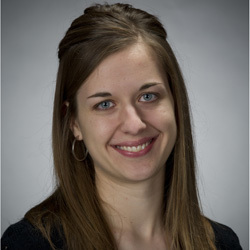
Two graduate students at the University of Notre Dame were the second annual recipients of the Berry Family Foundation Graduate Fellowships in Advanced Diagnostics & Therapeutics. The Berry Fellowships recognize outstanding contributions by Notre Dame graduate students in research related to improving human and environmental health. The recipients of the 2014–2015 fellowships were Kelsey Weigel of the Department of Biological Sciences and Md Itrat Bin Shams of the Department of Electrical Engineering.

Kelsey Weigel
Kelsey Weigel is developing a novel immunotoxin-based therapy treatment for ErbB2-positive breast cancer.
“Previous therapies have targeted this receptor, but the success of the therapies is challenged by the inevitable development of chemotherapeutic resistance,” Weigel notes.
Her project addresses this challenge by designing immunotoxins tailored to specifically attack ErbB2/HER2-positive cells while leaving normal cells relatively unharmed. These immunotoxins are uniquely designed to kill ErbB2/HER2-positive cells immediately, thus preventing their ability to become resistant.
“Now that these immunotoxins have been developed,” she says, “the objectives are to carry out extensive pre-clinical analysis of their efficacy in in vitro and, eventually, in vivo settings. We plan to optimize all steps for the duration of the treatment with the hope that in vivo modeling in immunocompromised mice will follow with the promise of developing novel therapeutics that will enhance the treatment options and improve the survival rates of patients diagnosed with ErbB2/HER2-positive cancer.”

Md Itrat Bin Shams
Md Itrat Bin Shams’ project is to investigate, improve and apply his group’s recently developed PI-CAI (photo-induced coded-aperture imaging) technique for potential early detection of skin cancer. PI-CAI is a fast, high-performance and cost-effective THz imaging technique suitable for many important medical applications.”
Shams describes the advantage of THz imaging over x-ray imaging: “THz imaging in medical settings tends to be less invasive and less destructive than the conventional x-ray imaging technique. THz imaging has already been demonstrated to have the potential for skin cancer detection and human teeth cavity identification. Preliminary works have shown that THz radiations can be used to differentiate healthy and unhealthy tissues in liver, breasts, artery, etc. Although THz imagers are currently available in the industry, they tend to be very complex and expensive. A fast and cost-effective THz camera with video-rate imaging capability that can be used in surgical incision in real-time is yet to be demonstrated.”
These graduate student fellowships are made possible through a generous gift from the Berry Family Foundation. They support the work of young researchers, generally in fields of science or engineering, who are tackling issues of high interest within Notre Dame’s Advanced Diagnostics & Therapeutics initiative. Fellows receive support for the studies as well as travel expenses for an academic year.
Originally published by Melissa Endres at advanceddiagnostics.nd.edu on June 13, 2014.